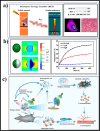Heterojunction semiconductor nanocatalysts as cancer theranostics
- PMID: 39381587
- PMCID: PMC11459490
- DOI: 10.1063/5.0223718
Heterojunction semiconductor nanocatalysts as cancer theranostics
Abstract
Cancer nanotechnology is a promising area of cross-disciplinary research aiming to develop facile, effective, and noninvasive strategies to improve cancer diagnosis and treatment. Catalytic therapy based on exogenous stimulus-responsive semiconductor nanomaterials has shown its potential to address the challenges under the most global medical needs. Semiconductor nanocatalytic therapy is usually triggered by the catalytic action of hot electrons and holes during local redox reactions within the tumor, which represent the response of nontoxic semiconductor nanocatalysts to pertinent internal or external stimuli. However, careful architecture design of semiconductor nanocatalysts has been the major focus since the catalytic efficiency is often limited by facile hot electron/hole recombination. Addressing these challenges is vital for the progress of cancer catalytic therapy. In recent years, diverse strategies have been developed, with heterojunctions emerging as a prominent and extensively explored method. The efficiency of charge separation under exogenous stimulation can be heightened by manipulating the semiconducting performance of materials through heterojunction structures, thereby enhancing catalytic capabilities. This review summarizes the recent applications of exogenous stimulus-responsive semiconducting nanoheterojunctions for cancer theranostics. The first part of the review outlines the construction of different heterojunction types. The next section summarizes recent designs, properties, and catalytic mechanisms of various semiconductor heterojunctions in tumor therapy. The review concludes by discussing the challenges and providing insights into their prospects within this dynamic and continuously evolving field of research.
© 2024 Author(s).
Conflict of interest statement
The authors have no conflicts to disclose.
Figures







References
-
- Zhang R., Yan X., and Fan K., “ nanozymes inspired by natural enzymes,” Acc. Mater. Res. 2(7), 534–547 (2021).10.1021/accountsmr.1c00074 - DOI
Publication types
LinkOut - more resources
Full Text Sources

